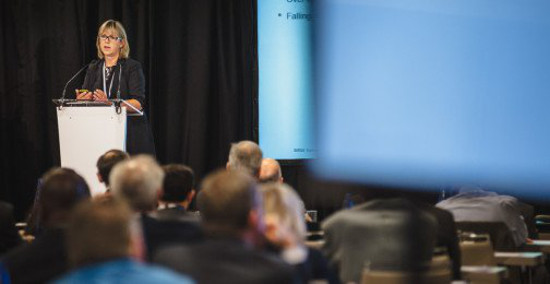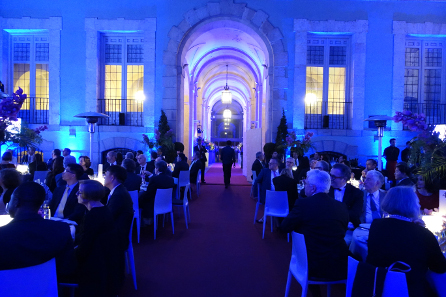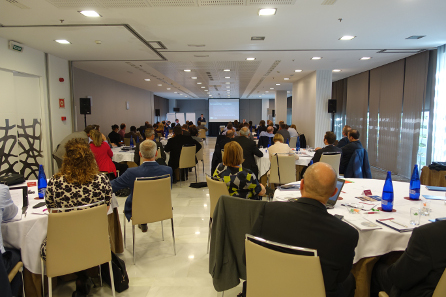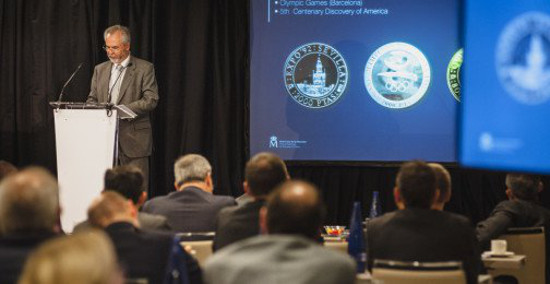by Ursula Kampmann
translated by Annika Backe
November 12, 2015 – The Coin Conference is something different than the Technical Forum of the World Money Fair, the Mint Directors Conference or the TEMAN, the Technical Meeting of Mints in ASEAN. The Coin Conference does not primarily address technical issues and discusses marketing, customer strategies or successful commemorative coin programs. Rather, it is the platform for central banks and their concerns. How to produce the most economically viable range of circulating coins? How to arrive at the most effective logistics between a central bank, a bank, the consumers and logistics centers? Where does all the change go, and how to retrieve it? How does a counterfeit-proof coin look like nowadays?
In addition, there are seminars where, in collaboration with experienced representatives of the supplying industry, current topics are addressed.
Astrid Mitchell, mainly responsible organizer of the Coin Conference. Photo: Reconnaissance.
The Coin Conference is organized by Reconnaissance, a British company specialized in the transfer of knowledge for central banks all around the world. The portfolio of Reconnaissance, therefore, not only comprises books and reports but several newsletters of superior professional qualifications with which Reconnaissance gives a monthly account of a range of topics from various sectors of circulation. Furthermore, Reconnaissance hosts a number of conferences. As a general rule, these conferences do not so much focus on coins but on issues as high-security printing, as applied for banknotes and documents, on tax stamps and certain security features as applied in the printing process.
The Coin Conference, on the other hand, is an event of recent date. The meeting in Madrid was only the third of its kind. Taking place in London in 2010 for the first time, it has soon become established in the world of the central banks.
Gala dinner in the premises of the Real Academia de Bellas Artes de San Fernando. Photo: UK.
At the latest Coin Conference, from October 21 to 23, 2015, nearly 200 delegates from more than 30 nations were present. The first official item on the agenda was a festive evening, the Mint of Madrid celebrating its 400th anniversary in 2015. On this occasion, the Mint invited the representatives of the central banks and the mints to an opulent gala dinner during which not just the Spanish cuisine presented itself in the best light possible. The event’s venue was the Real Academia de Bellas Artes de San Fernando. Founded in 1744, the list of its directors also includes Francisco Goya. Today not only painting, sculpture and architecture are taught at this academy of art, but likewise music, as was reflected by a marvelous one-hour concert which put the attendees in the right mood for dinner.
A glance in one of the workshops. Photo: UK.
The first day of the conference was devoted to two seminars. In the morning Davorin Dragas and Thomas Köninger of Monea welcomed the audience to join in the discussion about possible problems that may arise if technically inexperienced representatives of central banks and blank suppliers have to find an agreement on the specifications of blanks. Although one might think that everything is self-evident, during negotiations different assumptions often cause misunderstandings. To avoid disagreement after delivery it is necessary to stipulate in a contract precise and, most of all, measurable requirements after having reached an agreement on the methods of measurement.
As part of a quite densely packed program, Coins for Cash was the title of the second seminar chaired by Dieter Merkle of Germany-based press manufacturer Schuler. Assisted by many representatives of the Germany industry, he and his colleagues explained the diverse possibilities of present-day security technology in minting to the excitedly listening audience.
Eugenio Gomez gives his presentation on the new technology the Spanish Mint is famous for: latent images. Photo: Reconnaissance.
During the next two days, one lecture followed another. Two sessions were scheduled for the morning, and another two for the afternoon. Every twenty minutes, there was a new speaker at the desk. We will give a detailed summary of the lectures in another article soon.
At this point, a brief look at the topics may suffice: The first session focused on current trends in circulating coins and their role in the payments system. Session two revolved around changes in the monetary system and optimal logistics. The concerns of the central banks were at the heart of the first presentations held in the afternoon of the first day: The subject-matter was how to forecast how many coins were required and where, and how to arrive at the best distribution possible. The fourth session centered on the never-ending fight of the central banks against counterfeiting. New security features were introduced. Friday was devoted to sustainable company policy for mints, before members of central banks and mints elaborated on how their institution has solved problems specific to their country.
As you can see, the program was packed, interrupted by only very short breaks. There is, however, one thing that deserves special mentioning: it is hard to think of a congress with a better catering. The Spanish cuisine presented itself in the best light possible – not only during the gala dinner.
Here you can read the first part of a summary of all presentations held at the Coin Conference.
Here you can find the Coin Conference website.
Impressions of the Congress are given at this site.
More information about Reconnaissance is available here.
The site of the birthday institution, the Spanish Royal Mint, can be found here.
And, by the way, the Mint also has an impressive museum.








